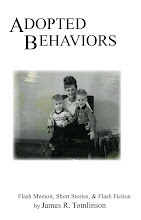3/5/11
"DEAD GIRL, LIVE BOY"
Why am I smiling? Why am I perfectly content with the image of an unwed mother and child, devoid of a father-figure, walking along Lake St. Clair, a lake that Michelle Brooks, author of “Dead Girl, Live Boy” describes in her novella as “a body of water that is beautiful in all seasons, but as polluted as a septic tank and unfit for swimming”? Why is it that I’m almost certain that that unwed mother is still wearing a wedding ring she stole from an ex-boyfriend, a wedding ring once adorning the finger of his dead wife? “I stole it because he kept it in this pretty little box like she was the most special thing in the world.”
In “Dead Girl, Live Boy,” the narrator, Josette, a social worker for Planned Parenthood and one-time Detroit auto show model, tells us about her ordeal as the legal guardian of her older brother Josh, a self-mutilator who “carved a grin underneath his mouth.” Together, both brother and sister have formed this toxic relationship where childhood games of “Head on a Stick” and “The Ceiling or the Floor,” have left them in perpetual survival mode, and for good reason: the childhood trauma they suffered at the hands of their father. We discover early on that something is seriously amiss with this family when their mother, who had wanted to keep their outward appearances intact, had warned them not to get into bed with their father. Josette says, “We never crawled into bed with him, but I can’t say we were always good at keeping him out of ours.”
You can’t help but feel the shockwaves, one ripple after another, as Josette self-medicates herself with prescription drugs (Vicodan, Fiorcette, codeine, xanax, valium, darvocette, percodan, Demerol …) and alcohol, has reckless sex, and finally admits how messed up her life has become. Her confession: “… I have a terrible fear of choking and yet I swallow more shit than anyone I know.” Her continuous need for companionship, to not be alone in the world, extends beyond her damaged brother to a married man, the married man’s son, and a bartender. None of which bring joy to her life. Her self-realization: “Is this what it means to be burned out—to be somewhere and not be somewhere? To do something well and not feel it? That would encompass most of my sex life.” Her fear of getting old: “…I dream that I have aged overnight, my dark circles blacker, my hair cut into layers, my skin grey and worn. In the dream, I tell myself that I have to accept how I look, that this new look must become what I consider beautiful, that I must live with it.”
Brooks’s fictional narrative has a dark, spooky edge to it—and why not? It takes place in Detroit from Halloween to Christmas—“… the season of rotting jack-o-lanterns, fallen leaves, the coming winter which always last longer than a person can endure …” Josette explains, “It’s strange to think that neither one of us has ever lived anywhere else, so the city acts as its own haunted house, memories like ghosts, lingering and ready to make you feel their chill the minute you stop expecting them.”
I guess what really intrigues me about “Dead Girl, Live Boy” is the imagery and foreshadowing throughout. One such example is the brother’s reaction to Josette’s divorce: “Josh hung up on me and sent me an e-mail the next day that had an attachment about a man who’d stabbed his girlfriend and buried her alive. She’d crawled out of her grave and arranged to break into a house and call 911 before passing out.” Another grave yard reference occurs earlier when Josette talks about her future ten years from now and how her parents may be dead by then: “I know that I will visit their graves often, if for nothing else, to make sure they’re still in them.” With lines like that, how can you not feel uncomfortable? How could you not want to see the aftermath of this train wreck in the making?
I strongly recommend that you read “Dead Girl, Live Boy” by my former mentor, Michelle Brooks. She’s one hell of a writer. It’s been five years since I sat in her fiction writing class, but I’m stilling learning from her and hope to one day collaborate on a project, even if it’s to shag coffee and sharpen pencils. Here’s the link if you’re interested in purchasing her novella: Storylandia presents: "Dead Girl, Live Boy".
Subscribe to:
Post Comments (Atom)






7 comments:
What an excellent, thorough, yet highly readable review!
I'll simply have to read Michelle's book
I kind of feel that I owe her one.
I do believe in one of the Eight Mile High creative writing courses out your way-- she recommended me as required reading.
Well. Required reading of Michelle is now on the agenda for old Ivan.
That is a good review. The book does seem interesting. I always wonder what drug taking experiences are about, since we don't read about them, or experience them much in Indian community.
...or maybe, I am just the one who hasn't heard about them here...
I'm looking forward to reading this one.
I am just glad that Brooks only thinks like this because if she acted like Josette I would never let her or her brother near me when I was passed out with a sharp instrument.
JR-I too, will help with the collaboration! I'll mix the lovely Michellabella her favorite cocktail and make her the tiny little snacks she prefers! Don't leave me out of the fun!
It sounds very intriguing, JR.
Thanks everyone for the wonderful comments.
Jodi, if you'll be fixing cocktails, then I'll definitely be making coffee.
Also, a special thank-you to Storylandia's editor, Gina Mayerson, for posting the link, and of course Michelle Brooks herself, for writing such a dark novella.
Post a Comment